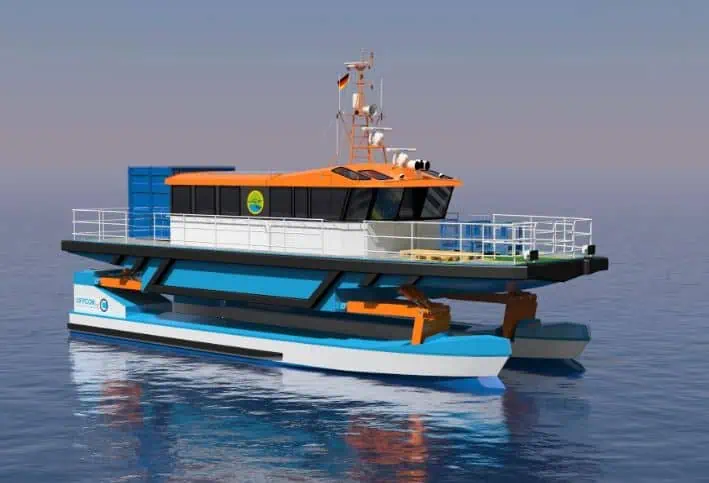The first commercial boat equipped with a suspension system could be a gamechanger for the offshore wind market. Share this news item
What if a vessel could be significantly smaller than a conventional crew transfer or service operation vessel yet able to withstand the rough seas during the transfer to and whilst at a wind turbine generator? A vessel like this could be a gamechanger for the offshore wind industry – minimising the carbon footprint and increasing efficiency while reducing the cost of operations. Wallaby Boats GmbH of Kappeln (Germany) and its crew transfer/daughter craft WB Wind are building such a vessel – the first commercial boat equipped with a suspension system and selected Lloyd’s Register (LR) as its classification provider.
The suspension system from Down Under
The vessel is basically a catamaran with a suspension system connecting the hulls and chassis. Developed and designed by Nauti-Craft Pty Ltd in Australia, the hydromechanical suspension allows the hulls to move independently of the vessel’s chassis, absorbing harsh, slamming impacts when operating at high speed in tough conditions. With the propulsion and power generating systems placed in the hulls and the hydraulic unit and batteries stored underneath the chassis, there is free space on deck for cargo, passengers, equipment and automatic crew lifts.
Wallaby Boats, which was founded specifically to design and construct this innovative project, will design and build a series of vessels ranging from 14-meter daughter crafts/service operation vessels to 20-meter crew transfer vessels. The prototype, WB 18 Wind, was classified by LR, and will go through heavy weather trials in the Baltic Sea and will also be tested in the rougher environments of the North Sea and the English Channel.
Safety up, cost down
The suspension system allows the comparatively small vessel to withstand significant wave heights as well as transport crewmembers to and from offshore wind parks. The demonstrator currently under development is designed as a crew transfer vessel seating 31 persons including 2 crew members. As the suspension system can buffer the impact of even large waves, the passengers will be subjected to less motion and g‑forces during transit. This reduces the risk of seasickness and number of accidents, even in harsh weather, making crew transfers safer and more reliable. The vessel’s heated walkways and handrails can also improve safety in adverse conditions.
Due to its smaller size and substantial wave performance, even at high speeds, the vessel offers savings on resources and cost, reducing CapEx by up to 30% and OpEx by roughly 50%. Not surprisingly offshore wind developers have already shown interest in the project, with EnBW providing funds and a long-term charter following the Sea Acceptance Test.
Mission: zero carbon footprint
Aiming for a net zero carbon footprint in production and operation of the new vessels, Wallaby Boats is building the demonstrator in accordance with ISO 18001, Blue Angel Ship Design and EU Ship Recycling Regulation standards.













